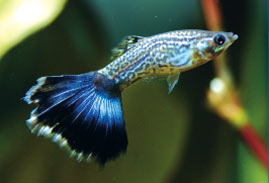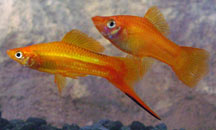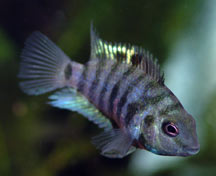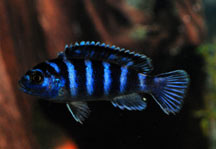Breeding Tropical Fish: An Introduction
Since it will usually take the babies 4-6 weeks to be large enough to be released, a separate rearing aquarium is a better option than a breeder trap. This could be a 5-20 gallon tank with a sponge filter, heater and a bare bottom. Having no substrate makes it easier to see uneaten food and vacuum it out after feeding. Use plastic plants with plant weights to provide some cover for the fish.
Once again, if you want to raise the babies, it is best to remove the rock with the eggs attached to a hatch-out/rearing tank. Fill this tank with water from the display aquarium. Do not allow the rock and eggs to be exposed to air during the transfer; encircle it with a plastic container or bag before removing it from the aquarium. You can feed the babies freshly hatched brine shrimp, TetraMin baby food "E" or standard flakes which have been ground into a powder. Other egg-laying African Cichlids can be set up in a "species tank," often with spectacular results. Julidochromis and Neolamprologous species can be placed in tanks providing 20 to 55 gallons of water. You will need to nearly fill the tank with rocks to provide the cover and security for the spawning pair. It is best to start with at least 6 fish, allowing them to sort out the pairs. The "odd-man-out males" will usually end up hiding in the corners and it is best to get them out of the aquarium. The breeding pair will select a cave and disappear into it for up to 10-14 days, and suddenly there will be a small cloud of babies. Unlike other Cichlids, these will tolerate the babies and breed again until the tank is full of many generations of fish. So do your research on your individual species, provide them with their own fry tank, and then sit back and enjoy all of the new offspring.
Most mouth brooders will require several females to each male, and usually just one male of the species per tank. After spawning, the female will carry the babies in her mouth for up to 2 weeks. It is best to carefully catch the female and remove her to a separate aquarium about 5 to 7 days after spawning. If the female spits the eggs or babies out during the transfer to the raising tank, she will usually pick the babies back up. During this time, the female will usually refuse to eat, although on occasion, Females eat some flaked food with the eggs still in their mouth. Again, a bare bottom tank is best, but more cover is required to make the female "at home"; plastic plants and more PVC pipes will do the trick. Once the female has released the babies, you need to move her to another aquarium and feed her really well for a week or two in order for her to regain strength before placing the fish back into the spawning tank. This will give her time to recover from not eating while carrying the eggs/babies. Then the whole cycle will start again. The babies are ready to start eating ground Spirulina flakes, and chew on a Spirulina disc as it sits in the aquarium. Frequent water changes will be the key to rapid growth of the babies to a marketable size. |
||||
|
|
||||









